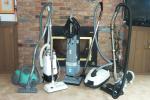Search engine visitors - click here to access entire "$ensible Home" web site
Click here to see a descriptive illustration showing several microfiltration vacuum cleaners.
Dear Jim: I have a fairly airtight, efficient home, but I am concerned about allergies/indoor air quality. I need to get a new vacuum cleaner. What designs are best for the most deep cleaning and best air? - Sarah K.

A: We are flooded with ads for so-called "allergy-safe" vacuum cleaners. Prices range from several hundred to more than a thousand dollars. There are even some new robot models that continually vacuum your rooms, recharge themselves and have built-in sonar to avoid furniture and stairs.
Canister-style vacuum cleaners often have the greatest deep cleaning power. They use powerful motors, 1200 watts or more, and the compact air flow path results in high air flow. It is the air flow velocity at the tool inlet which causes the dirt particles to be drawn into the vacuum cleaner.
Don't necessarily be impressed by marketing hype showing the vacuum cleaner hose has enough suction to pick up a bowling bowl. High suction (measured in inches of water lift) does not always result in high air velocity at the tool. The internal design and filters also affect air flow velocity.
Even the most powerful vacuum cleaner is not effective if it cannot keep the dust and allergen particles inside of it. This is a function of the quality of the filtration system and the airtightness of its construction. From my testing, price is not the best indicator of cleaning effectiveness.
It would be wise to select a model with a HEPA filter. HEPA filters were originally designed for hospital operating rooms. The entire system, not just the final filter, on several European models ("true-HEPA") meets HEPA standards. After vacuuming with one of these, the room air is actually cleaner.
Multistage filters are the most effective. Look for models with two filters and a bag or just the two filters on a bagless model. A design with a filter before the motor and a HEPA exhaust filter after the motor is effective. The HEPA filter also catches the fine dust from the electrical brushes inside the motor. Optional charcoal filters also remove room odors.
Before you select a vacuum cleaner, open it and remove the filters. Inspect the quality of seals around the filters, particularly the exhaust filter. There is a vacuum in front of the motor, so just some air might leak in a poor seal. The air after the motor is under pressure, so these seals are most important.
The HEPA bag and bagless models performed equally well when I tested them. I personally prefer a bagless one because I can watch the dirt and cat hair accumulate in the dust cup and know when to empty it. If you select a bag model, a "bag-full" indicator is a convenient feature. Another nice feature is an electronic suction control on the handle and telescopic wand for comfort.
Instant Download Update Bulletin No. 849 - buyer's guide of 12 manufacturers (31 models) of HEPA and true-HEPA canister/robot vacuum cleaners listing style (canister or upright), cleaning power (water lift in inches and air flow in cfm), filtration methods, dust bag capacities, length of cord, features, weights, illustrations, prices and descriptions of several models, chart of particle size of common air contaminants.
Dear Jim: I heat and air-condition my home year-round except on some nice days during spring and fall. There are tiny ceiling cracks during winter, but they close up during the summer. How can I stop this? - Laura F.
A: Unfortunately, you probably cannot stop them from opening and closing. Even though you heat and air-condition, the temperature and humidity inside your home vary through the seasons making the cracks change.
When the cracks are at their widest during the winter, fill them with drywall compound and sand them smooth. This will hold in better than spackling. Hopefully, it will stay in the cracks for several years.